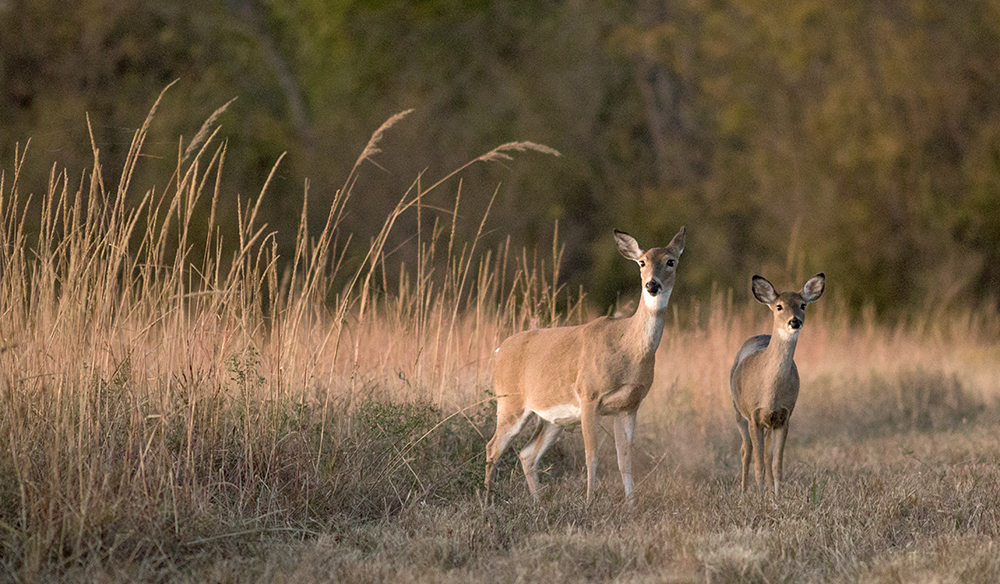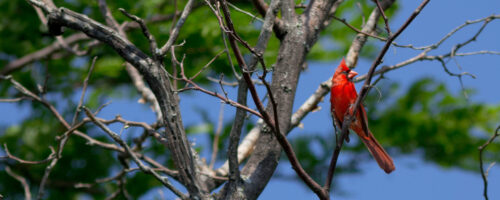Wildlife Watch: Build Diversity And Enterprise Income By Tracking Deer And Other Wildlife Populations
Monitoring wildlife populations and variety on your ranch can be a barometer and a decision-making tool.
There are many ways to increase diversity in a regenerative ranching operation, be it in the livestock you run or the forage species you grow. Another way is to provide an environment that’s conducive to a variety of wildlife species.
Josh Gaskamp, consultation manager and wildlife and range consultant at Noble Research Institute, says being aware of the wildlife on your land is important for a number of reasons.

Monitoring Wildlife on Noble Ranches
For years, Noble Research Institute used spotlight and game camera surveys to track wildlife populations on the 14,000 acres that make up the Noble Ranches.
About five years ago, the wildlife team realized they could get a lot more data for a lot less effort by using crowdsourcing, says Josh Gaskamp, consultation manager and wildlife and range consultant at Noble.
“We use a cloud-based survey tool on smartphones so that when one of our staff is out running across the ranch, if he or she sees 10 turkeys, they can log that,” he says. Noble also requires employees who hunt and fish on the ranches to log their sightings (or hearings), and use that as the primary source of data collection.
Gaskamp says there is a series of questions they ask employees every time they’re out on the ranches:
- Did you hear a quail?
- Did you hear a coyote?
- Did you hear or see a bobcat?
- Did you see or hear turkeys?
- How many whitetail deer?
- How many feral hogs did you see?
“It takes some half a second to answer it, and they move on. But that’s just one of the perks or one of the responsibilities that they have for getting to hunt or recreate on Noble properties,” he says.
Ranchers could use an app or a notebook to do the same, and write leases to ask hunters, fishermen, campers and birders to record what they see and hear in addition to logging their harvest.
The presence of deer, small mammals and even their predators is an important indicator of how well a ranch is being managed in sync with nature. At the same time, diverse wildlife species give back to the land, serve as a renewable recreational resource and provide an important ecosystem service to the public at large.
“If you have three ruminant species – cattle, sheep and goats, for instance – on a ranch, that’s better for the soil and vegetation community than just having one of those three,” Gaskamp says.
“Same thing goes for wildlife. Different wildlife species have different niches. They use different plant species, have different digestive systems and different ways of scattering seed,” he says. “The differing impacts to the soil and vegetation community help to get carbon back in the ground instead of in the atmosphere. More species create more opportunity to build the soil, if managed correctly.”
The fragmentation of some large ranches, along with a prevalence of monoculture grasslands, has affected indicator species such as quail, he says, but “all ranchers working together in a community to manage habitats for similar goals, i.e., doing regenerative ranching, can absolutely benefit some of those indicator species.”
The way nature and the populations respond “can show us that we’re doing better for the soils, better for the diversity of plants and wildlife for the public benefit,” Gaskamp adds.
Avoid wildlife deserts
Gaskamp describes what can happen to wildlife when “we humans brought in bermudagrass as a substitute forage for cattle. In a conventional setting, we fertilize it, we spray it for weeds. I oftentimes refer to that as a ‘wildlife desert,’ because there’s no diversity.”
Not only is it just one species of plant, but the chemical additives affect the biology under the ground, further limiting diversity. It takes a toll.
“White-tailed deer can eat 100 pounds a day of bermudagrass, and they’ll starve to death,” he says. “It doesn’t have the nutrient requirements a white-tailed deer needs. If you see a deer in a bermudagrass pasture, it’s eating what small forbs it can find.”
Deer are selective eaters, seeking out the highest-quality parts of forbs, woody species and some grasses. Having a diversity of plants out there provides adequate nutrition and attracts more wildlife species, Gaskamp says.
“That’s just one reason why it’s important to have a polyculture growing rather than a monoculture.” In fact, it’s mostly only in monocultures, such as wheat pastures, that deer compete with cattle for forage. They fit in great with multi-ruminant regenerative grazing in polyculture forage, he says.
“Some would believe deer and small ruminants are huge competitors. They can be, but they can also be managed to complement one another,” Gaskamp explains. “When livestock are rotated or adaptively grazed, you often see deer concentrate on a particular pasture or area of the ranch a couple weeks after the sheep or goats leave it. The vegetative regrowth from previously grazed plants is highly nutritious to the deer.”

Monitor well to manage well
So, how can you know how diverse your wildlife population is, and how your management is affecting it over time?
While there are several scientific ways to measure species richness, Gaskamp says ranchers need something simple and time-efficient to help them monitor their own wildlife populations. And what’s easy for one may not be easy for another, so trial and error is important.
“We’re talking about just having our finger on the pulse of what the wildlife populations are doing in response to my management, and if they’re going the wrong way, considering alternatives.”
For years, Noble Research Institute did spotlight surveys and set up game cameras – all very time-intensive. To align its methods to emulate what it would advise for ranchers, “we’ve transitioned our monitoring of our wildlife populations to crowdsourcing,” he says. Employees and others who hunt on Noble Ranches are asked to keep a log of what they see when they’re out – ground-nesting birds, deer, feral hogs. He suggests ranchers request the same of hunters on their land.
For ranchers themselves, “it could be as simple as, ‘Well, every day I go check the cows, I’m gonna count how many turkeys and deer I see. I’ll just jot that number down and keep a trend line.’” Pick some days in quail mating season and count how many calls of males you hear.
When it comes to monitoring small mammals that are mainly active at night, like rabbits or rats, Gaskamp says you can get an idea of what those populations look like by understanding what the predator population is. Note coyote and bobcat sightings to know if you have plenty of their small-mammal prey on your property.
He gives one last note on monitoring and tracking data: “If you’re not gonna make any decisions from it, there’s no need to collect it.”
But seeing what happens to wildlife populations after you’ve made a management change can be valuable for making future decisions.

Predators are part of the system
Gaskamp notes that Noble Ranches staff are keen on watching predator populations, given the “artificial” increase in prey population on the ranches running sheep and goats. Guardian dogs keep the small ruminants safe; he says the coyotes and bobcats just give them a wide berth.
“We’re not out there trying to remove coyotes. They help maintain the health of white-tailed deer populations and help us control populations of feral hogs, so they are an asset to us,” he says. Turns out young feral hogs are slow, clumsy and one of the easiest prey for coyotes to catch.

Wildlife can bring enterprise opportunities
Remember that wildlife – whether it is deer, quail or turkey for hunting; fish, waterfowl and shorebirds in a well-stocked pond for fishing; or residents of a unique habitat for birders – can be an economic enterprise to boost ranch income.
Gaskamp lists hunting and fishing leases, wildlife-viewing opportunities and even camping (or glamping) as ways to connect people with nature while deriving income from your wildlife population.
“It’s a renewable resource,” he says. “Ranchers can utilize that resource and derive a little bit of profit from recreational leasing, and the deer, quail and turkey populations will respond. They will do just fine.”
Note: This article is part three of three in our Wildlife Watch series about monitoring and managing wildlife on regenerative ranches.



Comment